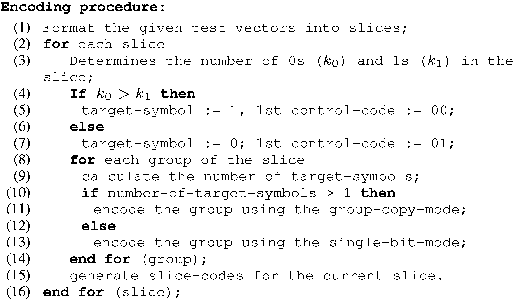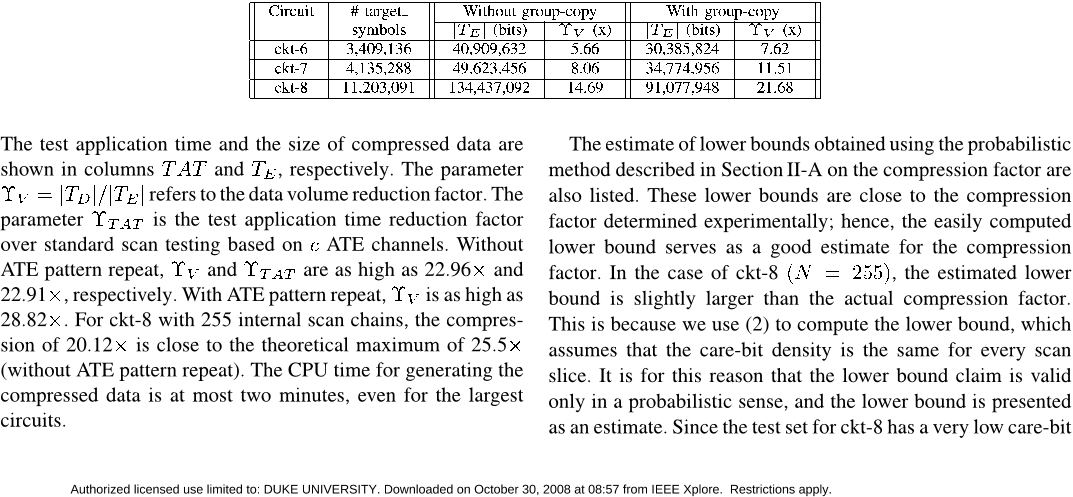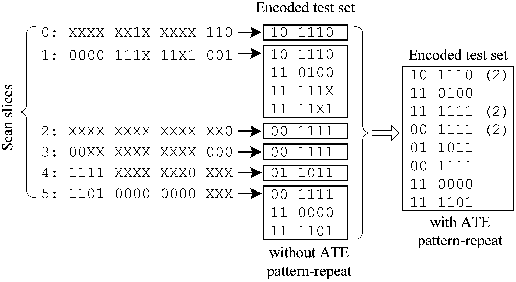




Did you find this useful? Give us your feedback


![TABLE IX COMPARISON WITH THE TEST DATA MUTATION METHOD [29]](/figures/table-ix-comparison-with-the-test-data-mutation-method-29-3tu728xs.png)




![TABLE VIII COMPARISON WITH THE ADJUSTABLE WIDTH LINEAR COMBINATIONAL DECOMPRESSION [28]](/figures/table-viii-comparison-with-the-adjustable-width-linear-3aqhpwn0.png)
![TABLE VII COMPARISON WITH RECENT DICTIONARY-BASED COMPRESSION METHOD [18]](/figures/table-vii-comparison-with-recent-dictionary-based-3ibzk143.png)




![TABLE VI COMPARION WITH 2-D COMPRESSION [21]](/figures/table-vi-comparion-with-2-d-compression-21-2pi4kysb.png)








25 citations
...Therefore we have four categories: fixed-to-fixed [2], [3], fixed-to-variable [4]–[13], variable-to-fixed [14]–[17], and variable-to-variable [18]–[32]....
[...]
...They are based on the fact that even in compacted test sets the percentage of unspecified bits is large [1], [17]....
[...]
22 citations
...We also compare our method with the Illinois scan [Shah and Patel 2001] and selective encoding [Wang and Chakrabarty 2008] on stimulus test data volume for the IWLS2005 circuits....
[...]
...…1.32 vga 32 17079 9211 44947048 8297 23459759 9500385 10907846 6.04 6.89 21.14 40.50 10.16 In Tables VI and VIII, we present a comparison of the proposed method with the Illinois scan [Shah and Patel 2001] and selective encoding [Wang and Chakrabarty 2008] on stimulus data volume compression....
[...]
...As shown in Tables VII and VIII, FFs and faults represent the number of scan .ip-.ops and the number of transition faults....
[...]
...It is found that the proposed method obtains much less stimulus data volume, as compared to the Illinois scan [Shah and Patel 2001] and selective encoding [Wang and Chakrabarty 2008] for the ISCAS89 circuits....
[...]
...Performance of Scan Flip-Flop Grouping Scheme in Xiang et al. [2007a] for LOC Transition Delay Fault Testing cir. faults FFs FC FC new untestable R1 R2 gs s13207 15602 669 82.53 65.48 2661 28.54 30.85 4 s15850 19046 597 78.8 63.1 2991 19.32 22.54 6 s35932 62798 1728 87.2 78.35 5558 0.98 1.14 158 s38417 49738 1636 96.8 84.04 6347 7.11 8.33 20 s38584 61254 1452 90.76 81.27 5814 7.49 9.65 16 usb 76917 1746 96.65 86.43 7861 8.24 8.91 17 pci 118107 3359 97.64 80.26 20527 6.04 7.14 22 des 448789 8808 99.99 92.3 34512 0.55 0.82 327 vga 700141 17079 98.62 85.99 88428 3.32 3.71 40 Table X. Performance of the Folded Scan Forest with Different Numbers of Scan-In Pins circuits case 1 case 2 case 3 Sin R1 R2 TA Sin R1 R2 TA Sin R1 R2 TA s13207 8 27.81 53....
[...]
12 citations
11 citations
...Scan forest was combined with selective encoding (Wang and Chakrabarty 2008) to compress test data of cores, but the new article uses only scan forest to compress test data inside cores. Therefore, due to the use of different DFT architectures, test data and the test delivery time for the new method are more than that in Xiang (2016a). The cores assigned to the 3D stacked NOCs are different from the ones in this article....
[...]
...Scan forest was combined with selective encoding (Wang and Chakrabarty 2008) to compress test data of cores, but the new article uses only scan forest to compress test data inside cores. Therefore, due to the use of different DFT architectures, test data and the test delivery time for the new method are more than that in Xiang (2016a). The cores assigned to the 3D stacked NOCs are different from the ones in this article. In the NOCs with four core classes, three core classes, and a single core class, circuits (b19, des, ethernet, vga), (b19, des, vga), and (b19) are randomly assigned, respectively. In this article, des is replaced by netcard for the first two cases, (vga, netcard), (netcard) are randomly assigned for two core classes and a single core class. The above two reasons contribute to the difference in the core test cost between the new method and the one in Xiang (2016a). The fault-tolerant multicast approach for core testing is not affected much by the number of link/router failures....
[...]
...Scan forest was combined with selective encoding (Wang and Chakrabarty 2008) to compress test data of cores, but the new article uses only scan forest to compress test data inside cores. Therefore, due to the use of different DFT architectures, test data and the test delivery time for the new method are more than that in Xiang (2016a). The cores assigned to the 3D stacked NOCs are different from the ones in this article. In the NOCs with four core classes, three core classes, and a single core class, circuits (b19, des, ethernet, vga), (b19, des, vga), and (b19) are randomly assigned, respectively. In this article, des is replaced by netcard for the first two cases, (vga, netcard), (netcard) are randomly assigned for two core classes and a single core class. The above two reasons contribute to the difference in the core test cost between the new method and the one in Xiang (2016a). The fault-tolerant multicast approach for core testing is not affected much by the number of link/router failures. However, the router testing approach is very sensitive to these failures, which may increases the number of internal router test sessions. As the size of an NOC increases, the new router testing approach becomes less sensitive to the number of failures. The router test cost for the new method is much less than that in Xiang (2016b), because concurrent test delivery and test application for router testing are utilized....
[...]
...Scan forest was combined with selective encoding (Wang and Chakrabarty 2008) to compress test data of cores, but the new article uses only scan forest to compress test data inside cores....
[...]
5 citations
178 citations
...Another category of compression methods uses statistical coding, variants of run-length coding, dictionary-based coding, and hybrid techniques [17]–[22]....
[...]
175 citations
155 citations
...The proposed input compression method can be used with recent output compaction methods such as X-compact [2], convolutional compaction [25], and i-compact [26] to further reduce test data volume....
[...]
139 citations
136 citations
...The proposed input compression method can be used with recent output compaction methods such as X-compact [2], convolutional compaction [25], and i-compact [26] to further reduce test data volume....
[...]